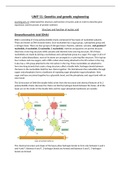Essay
Unit 11: Genetics and Genetic engineering Learning aim A: Understand the structure and function of nucleic acids in order to describe gene expression and the process of protein synthesis
- Course
- Institution
This assignment got a distinction grade and my final grade for the course was D*D*D. I only upload the work I got D grades for. A.D1 Assess the impact of error in the stages of protein synthesis. A.M1 Discuss the functional role of nucleic acids in DNA in the stages of protein synthesis. A.P1 E...
[Show more]



